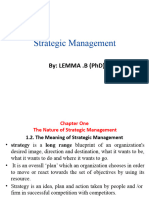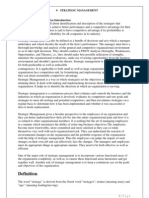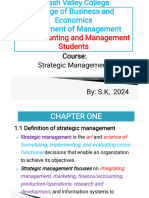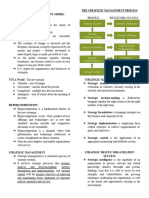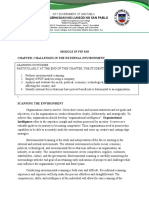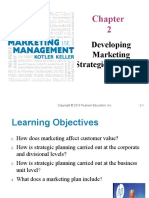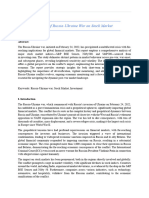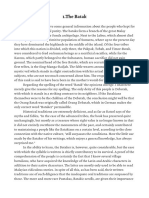0% found this document useful (0 votes)
134 views11 pagesDalubhasaan NG Lunsod NG San Pablo: The Reality of Dynamism
This document discusses strategic management and the dynamic business environment. It defines strategic management as a continuous process involving strategic analysis, decision-making, formulation, implementation, and control to align policies and goals with the external environment. The business environment is dynamic and uncertain due to constant changes and global competition. Hypercompetition results from globalization and new technologies, forcing companies to continuously outperform competitors through innovation, quality, and supply chain management. Strategic management helps organizations evaluate strengths, vulnerabilities and opportunities to develop strategic intelligence and competitive strategies for achieving objectives.
Uploaded by
jchazneyCopyright
© © All Rights Reserved
We take content rights seriously. If you suspect this is your content, claim it here.
Available Formats
Download as DOCX, PDF, TXT or read online on Scribd
0% found this document useful (0 votes)
134 views11 pagesDalubhasaan NG Lunsod NG San Pablo: The Reality of Dynamism
This document discusses strategic management and the dynamic business environment. It defines strategic management as a continuous process involving strategic analysis, decision-making, formulation, implementation, and control to align policies and goals with the external environment. The business environment is dynamic and uncertain due to constant changes and global competition. Hypercompetition results from globalization and new technologies, forcing companies to continuously outperform competitors through innovation, quality, and supply chain management. Strategic management helps organizations evaluate strengths, vulnerabilities and opportunities to develop strategic intelligence and competitive strategies for achieving objectives.
Uploaded by
jchazneyCopyright
© © All Rights Reserved
We take content rights seriously. If you suspect this is your content, claim it here.
Available Formats
Download as DOCX, PDF, TXT or read online on Scribd
/ 11













